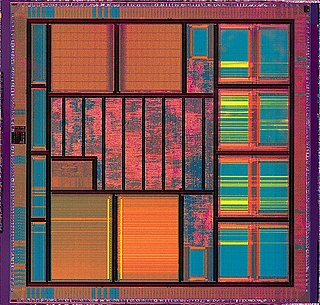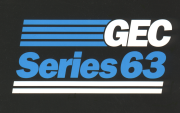Related Research Articles

Very-large-scale integration (VLSI) is the process of creating an integrated circuit (IC) by combining millions or billions of MOS transistors onto a single chip. VLSI began in the 1970s when MOS integrated circuit chips were developed and then widely adopted, enabling complex semiconductor and telecommunications technologies. The microprocessor and memory chips are VLSI devices.

Acorn Computers Ltd. was a British computer company established in Cambridge, England in 1978 by Hermann Hauser, Chris Curry and Andy Hopper. The company produced a number of computers during the 1980s with associated software that were highly popular in the domestic market, and they have been historically influential in the development of computer technology like processors.
The Fifth Generation Computer Systems was a 10-year initiative launched in 1982 by Japan's Ministry of International Trade and Industry (MITI) to develop computers based on massively parallel computing and logic programming. The project aimed to create an "epoch-making computer" with supercomputer-like performance and to establish a platform for future advancements in artificial intelligence. Although FGCS was ahead of its time, its ambitious goals ultimately led to commercial failure. However, on a theoretical level, the project significantly contributed to the development of concurrent logic programming.

Lynn Ann Conway was an American computer scientist, electrical engineer, and transgender activist.

Ehud Shapiro is an Israeli scientist, entrepreneur, artist, and political activist who is Professor of Computer Science and Biology at the Weizmann Institute of Science. With international reputation, he made contributions to many scientific disciplines, laying in each a long-term research agenda by asking a basic question and offering a first step towards answering it, including how to computerize the process of scientific discovery, by providing an algorithmic interpretation to Karl Popper's methodology of conjectures and refutations; how to automate program debugging, by algorithms for fault localization; how to unify parallel, distributed, and systems programming with a high-level logic-based programming language; how to use the metaverse as a foundation for social networking; how to devise molecular computers that can function as smart programmable drugs; how to uncover the human cell lineage tree, via single-cell genomics; how to support digital democracy, by devising an alternative architecture to the digital realm grassroots.

The PERQ, also referred to as the Three Rivers PERQ or ICL PERQ, is a pioneering workstation computer produced in the late 1970s through the early 1980s. It is the first commercially-produced personal workstation with a graphical user interface (GUI). The design of the PERQ was heavily influenced by the original workstation computer, the Xerox Alto, which was never commercially produced. The workstation was conceived by six former Carnegie Mellon University alumni and employees: Brian S. Rosen, James R. Teter, William H. Broadley, J. Stanley Kriz, Raj Reddy and Paul G. Newbury, who formed the startup Three Rivers Computer Corporation (3RCC) in 1974.

Semiconductor Research Corporation (SRC), commonly known as SRC, is a high-technology research consortium active in the semiconductor industry. It is a leading semiconductor research consortium. Todd Younkin is the incumbent president and chief executive officer of the company.

Microelectronics and Computer Technology Corporation, originally the Microelectronics and Computer Consortium and widely seen by the acronym MCC, was the first, and at one time one of the largest, computer industry research and development consortia in the United States. MCC ceased operations in 2000 and was formally dissolved in 2004.

The Centre for Development of Advanced Computing (C-DAC) is an Indian autonomous scientific society, operating under the Ministry of Electronics and Information Technology.
The Computer Arts Society (CAS) was founded in 1968, in order to encourage the creative use of computers in the arts.

The Centre for Development of Advanced Computing, Thiruvananthapuram (C-DAC[T]) is a branch of the Indian Centre for Development of Advanced Computing based in Thiruvananthapuram.

A transistor computer, now often called a second-generation computer, is a computer which uses discrete transistors instead of vacuum tubes. The first generation of electronic computers used vacuum tubes, which generated large amounts of heat, were bulky and unreliable. A second-generation computer, through the late 1950s and 1960s featured circuit boards filled with individual transistors and magnetic-core memory. These machines remained the mainstream design into the late 1960s, when integrated circuits started appearing and led to the third-generation computer.

The GEC Series 63 was a 32-bit minicomputer produced by GEC Computers Limited of the UK during the 1980s in conjunction with A. B. Dick in USA. During development, the computer was known as the R Project. The hardware development was done in Scottsdale, Arizona whilst the software was the responsibility of GEC in Dunstable, UK. The hardware made early use of pipeline concepts, processing one instruction whilst completing the preceding one.
Jack Howlett CBE was a British mathematician and computer scientist who was head of the Atlas Computer Laboratory for the duration of its existence.
The United States government's Strategic Computing Initiative funded research into advanced computer hardware and artificial intelligence from 1983 to 1993. The initiative was designed to support various projects that were required to develop machine intelligence in a prescribed ten-year time frame, from chip design and manufacture, computer architecture to artificial intelligence software. The Department of Defense spent a total of $1 billion on the project.
Brian Wynne Oakley, was a British civil servant and industrialist who took a leading role in the area of information technology, especially the 1980s Alvey Programme.

The Turing Institute was an artificial intelligence laboratory in Glasgow, Scotland, between 1983 and 1994. The company undertook basic and applied research, working directly with large companies across Europe, the United States and Japan developing software as well as providing training, consultancy and information services.

The history of Polish computing (informatics) began during the Second World War with breaking the Enigma machine code by Polish mathematicians. After World War II, work on Polish computers began. Poles made a significant contribution to both the theory and technique of world computing.
Lou Burnard is an internationally recognised expert in digital humanities, particularly in the area of text encoding and digital libraries. He was assistant director of Oxford University Computing Services (OUCS) from 2001 to September 2010, when he officially retired from OUCS. Before that, he was manager of the Humanities Computing Unit at OUCS for five years. He has worked in ICT support for research in the humanities since the 1990s. He was one of the founding editors of the Text Encoding Initiative (TEI) and continues to play an active part in its maintenance and development, as a consultant to the TEI Technical Council and as an elected TEI board member. He has played a key role in the establishment of many other activities and initiatives in this area, such as the UK Arts and Humanities Data Service and the British National Corpus, and has published and lectured widely. Since 2008 he has worked as a Member of the Conseil Scientifique for the CNRS-funded "Adonis" TGE.

John Darlington is a British academic, researcher and author. He is an Emeritus Professor at Imperial College London. He was Director of the London e-Science Centre and was head of the Functional Programming and Social Computing Sections at Imperial.
References
- ↑ Aleksander, Igor (2013). Decision and Intelligence, Volume 6. London: Kogan Page. p. 185. ISBN 9781850914075.
- ↑ "Alvey Report Background and Introduction". Computing at Chilton: 1961-1985. Retrieved 22 May 2021.
- 1 2 Alvey - Britain's Strategic Computing Initiative. MIT Press. 1989. ISBN 0-262-15038-7.
- ↑ Kakas, A. C.; Sadri, F. (2003). Computational Logic: Logic Programming and Beyond: Essays in Honour of Robert A. Kowalski. Berlin: Springer. p. 11. ISBN 3540439595.
- 1 2 Dodgson, Mark (2018-03-26). Technological Collaboration in Industry: Strategy, Policy and Internationalization in Innovation. Routledge. ISBN 9781351265584.
- ↑ "One small step forward is one giant leap backwards for government".
- ↑ "The Alvey Programme Overview". Computing at Chilton: 1961-1985. Retrieved 22 May 2021.
- ↑ "Alvey Report Summary of Recommendations". Computing at Chilton: 1961-1985. Retrieved 22 May 2021.
- ↑ Blackburn, J. F. (22 August 1985). The Alvey Conference in Edinburgh: A Review of the UK's Research Program in Computer Science. US Office of Naval Research. p. 3. Retrieved 22 May 2021.
- Brian Oakley and Kenneth Owen, Alvey: Britain's Strategic Computing Initiative, MIT Press, 1990. ISBN 0-262-15038-7
- Chris Rigatuso, Takeshi Tachi, Dennis Sysvester & Mark Soper, Collaboration between Firms in Information Technology, Berkeley, EE 290X Group G.
- Richard Tyler, The Daily Telegraph, Feb 9th 2010.